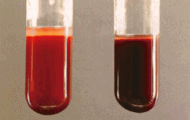Program Overview
The diagnosis of acquired methemoglobinemia requires a high index of clinical suspicion, confirmation with objective testing, and prompt specific treatment in addition to support. There are important clues to the diagnosis, especially a “saturation gap” between an arterial blood gas and pulse oximetry data, and careful history of drug use or potential toxin exposure. Because acquired methemoglobinemia is rare, clinicians should seek out and pursue education on the most up-to-date information on etiology, diagnosis, and treatment.
Target Audience
Emergency medicine physicians, intensivists, toxicologists, infectious disease specialists, oncologists, advanced practitioners, nurses, hospital-based pharmacists, and other healthcare professionals involved in the care of patients with acquired methemoglobinemia
Agenda
I. Patient Case 1 Analysis: An Ill Patient with an Oxygen Saturation Gap
II. Pathophysiology of Acquired Methemoglobinemia: Identifying the Usual Suspects, but in Context
III. Clinical Strategies to Improve Outcomes in Patients with Acquired Methemoglobinemia
IV. Patient Case 2 Analysis: Acute Decompensation in the ICU
V. An Interprofessional Approach to Treatment Plan Development & Patient Monitoring
Learning Objectives
- Discuss the pathophysiologic basis of methemoglobinemia, explain the origin of the “saturation gap,” and apply that to diagnostic evaluation
- Analyze available data on the various treatment options for acquired methemoglobinemia
- Develop therapeutic plans and monitor adverse side effects with the multidisciplinary care team to improve patient outcomes
Faculty
 Charles V. Pollack Jr., MA, MD, FACEP, FAHA, FACC, FESC (Course Chair)
Charles V. Pollack Jr., MA, MD, FACEP, FAHA, FACC, FESC (Course Chair)
Clinician-Scientist
Department of Emergency Medicine
University of Mississippi School of Medicine
Jackson, Mississippi
 John Fanikos, RPh, MBA
John Fanikos, RPh, MBA
Executive Director of Pharmacy
Brigham and Women’s Hospital
Boston, Massachusetts
 Frank Lovecchio, DO, MPH, FACEP, ABMT
Frank Lovecchio, DO, MPH, FACEP, ABMT
Professor, Research Scholar, University of Arizona
Emergency Medicine, Medicine and Pharmacology
Tucson, Arizona
Disclosures of Conflict of Interest
It is the policy of AcademicCME that all faculty, instructors, and planners disclose real or apparent conflicts of interest relating to the topics of this educational activity.
The faculty reported the following financial relationships or relationships to products or devices they or their spouse/life partner have with commercial interests related to the content of this CE activity:
| Faculty | Relationship Identified With: |
| Charles V. Pollack Jr., MD (Course Chair) | Grant/Research Support: AstraZeneca Pharmaceuticals; PROVEPHARM INC.
Consultant/Advisor: AstraZeneca Pharmaceuticals |
|
John Fanikos, RPh, MBA |
Consultant/Advisor: AstraZeneca Pharmaceuticals; Boehringer Ingelheim International GmbH; Portola Therapeutics, Inc.; Ipsen Pharmaceuticals, Inc.
Grant/Research Support: Boehringer Ingelheim International GmbH; Heron Therapeutics, Inc |
| Frank LoVecchio, DO | Grant/Research Support: National Institutes of Health
Speaker’s Bureau: Allergan |
Planners and Peer Reviewers
Timothy Hayes, MD, PhD; Kim Cheramie, MSN, RN-BC; Joseph Feick, PharmD; Gabrielle Fiorelli, CRNP and Nicole Brestowski state that they or their spouse/life partner do not have any financial relationships to products or devices with any commercial interests related to the content of this activity of any amount during the past 12 months.
Accreditation Statement
 In support of improving patient care, AcademicCME is jointly accredited by the Accreditation Council for Continuing Medical Education (ACCME), the Accreditation Council for Pharmacy Education (ACPE), and the American Nurses Credentialing Center (ANCC), to provide continuing education for the healthcare team. This activity was planned by and for the healthcare team.
In support of improving patient care, AcademicCME is jointly accredited by the Accreditation Council for Continuing Medical Education (ACCME), the Accreditation Council for Pharmacy Education (ACPE), and the American Nurses Credentialing Center (ANCC), to provide continuing education for the healthcare team. This activity was planned by and for the healthcare team.
Credit Designation Statements
AcademicCME designates this live material for a maximum of 1.0 AMA PRA Category 1 Credit TM.
AcademicCME designates this live material for a maximum of 1.0 CNE Contact Hour, including 1.0 Pharmacotherapeutic Contact Hour (Provider number P0491).
AcademicCME designates this continuing education activity for 1.0 CPE Contact Hour (0.10 CEUs) of continuing pharmacy education credit (UAN #: JA4008190-0000-20-012-H04-P).
Participants should claim only the credit commensurate with the extent of their participation in the activity.
Financial Support
This activity has been supported by an independent educational grant from PROVEPHARM INC.
Disclosure of Unlabeled Use
This educational activity may contain discussion of published and/or investigational uses of agents that are not indicated by the FDA. AcademicCME and PROVEPHARM INC. do not recommend the use of any agent outside of the labeled indications.
Disclaimer
Participants have an implied responsibility to use the newly acquired information to enhance patient outcomes and their own professional development. The information presented in this activity is not meant to serve as a guideline for patient management. Any procedures, medications, or other courses of diagnosis or treatment discussed or suggested in this activity should not be used by clinicians without evaluation of their patient’s conditions and possible contraindications on dangers in use, review of any applicable manufacturer’s product information, and comparison with recommendations of other authorities.
Method of Participation
In order to claim credit, participants must complete the following:
- Read the learning objectives, accreditation information and faculty disclosures at the beginning of this activity.
- Complete the Pre-Activity Questions
- Read or Review the activity content.
- Complete the Post-Activity Test Questions and Evaluation.
- Learners who receive a grade of 70% or better on the Post-Activity Test Questions and complete the Evaluation will receive appropriate credit as indicated (CME, CNE, and/or CPE credit).
- CPE credit will be posted to the learner’s CPE Monitor profile within 60 days of completion.
- CME and CNE credit will be issued appropriate certificate of completion.
- Others may request a “certificate of completion”.
- Learners should claim only the credit commensurate with the extent of their participation in the activity.
CE Inquiries/Special Needs
For all CE inquiries or special needs, please contact [email protected].



